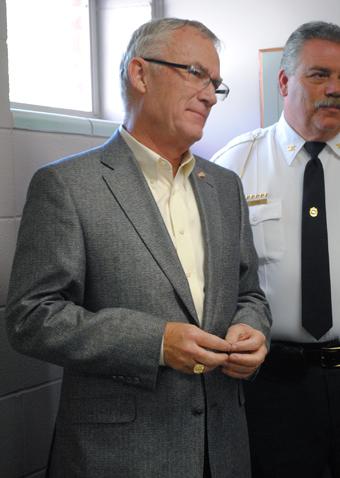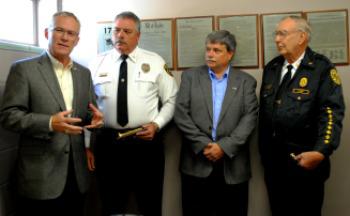
Approximately 500,000 hunters will take part in Missouri’s main firearms deer season Nov. 12 through 22. Last year, MDC recorded nine firearms-related hunting incidents during the 11-day hunt. Although none of those incidents was fatal, last year was far from the best for deer-hunting safety. That distinction belongs to 2004, when MDC recorded only four firearms-related deer hunting incidents, all nonfatal.
MDC Hunter Education Coordinator Tony Legg says one astonishing fact stands out about last year’s deer-hunting incidents. Eighty-seven percent of them were self-inflicted.
“Self-inflicted incidents are common every year,” said Legg, “but 2010 was a new high…or low point for deer hunters hurting themselves. The best advice last year would have been, ‘Look out for the guy in the mirror.’”
Following are brief descriptions of last year’s bumper crop of self-inflicted gunshot wounds and the violation of hunting-safety rules that caused them.
- A 55-year-old hunter chambered a cartridge in his semiautomatic pistol and was moving the safety into the “safe” position when the pistol discharged, striking the palm of his left hand. Safety Violation: Failed to keep the muzzle pointed in a safe direction.
- A 13-year-old leaned his rifle against the tree in his tree stand to get something out of his backpack. He bumped the gun, causing it to fall. The rifle’s external hammer struck one of the tree stand’s steps, and it fired, striking him in the finger. Safety violation: Firearm leaned against an insecure rest.
- A 42-year-old hunter loaded his muzzle-loading rifle and walked to his tree stand. He tied the rifle to a haul rope with the muzzle facing up. After climbing into his stand, the hunter was pulling the rifle up when it bumped an object and discharged, striking him in the upper chest and shoulder. Safety violations: Failed to unload firearm before hauling into tree stand and attached rifle to haul line improperly.
Legg said tree-stand safety should be another major concern for deer hunters. MDC only records injuries caused by firearms, so no one knows exactly how many hunters are injured, paralyzed or even killed in Missouri each year as a result of falls. However, Legg said the number is substantial and has grown with the increased availability and use of tree stands.
“Evidence suggests that injuries from tree-stand falls far outnumber those from firearms,” said Legg. “One study showed that one out of every three tree-stand users will fall at some point in their hunting career.”
He said tree stands don’t have to be dangerous. In fact, hunters have access to safer stands and better protective gear today than ever before. Furthermore, decades of experience have revealed the causes of tree-stand falls and enabled safety advocates to address them. Hunters who follow safety recommendations and use equipment approved by the Treestand Manufacturer’s Association (TMA) have little to worry about. He offered the following advice.
- Always wear a Fall-Arrest System (FAS) with a full body harness, even during ascent and descent.
- Read and follow manufacturer’s instructions before using a tree stand.
- Inspect the tree stand and the FAS before each use and dispose of worn or damaged equipment.
- Practice in your FAS at ground level before using it in an elevated position.
- Be aware of dangers that exist even with a FAS. Prolonged suspension in a harness can be fatal. Have in place a plan for rescue, including the use of cell phones or signal devices that may be easily reached and used while suspended.
- with a plan and if possible with a buddy. Before leaving home, let others know your exact hunting location and when you plan to return.
- Keep emergency signal devices, such as a cell phone, walkie-talkie, whistle, signal flare or flashlight, so they are within reach even if you are suspended in your FAS.
- Never hurry while climbing with a tree stand. Make slow movements of no more than ten to twelve inches at a time. Maintain three points of contact with each step on ladder stands.
Finally, MDC cautions deer hunters about two dangers associated with campfires. One is wildfire.
Much of Missouri is in a serious drought, heightening normal fire danger. Do not light a campfire unless the surrounding area has been cleared of leaves and other flammable materials. Don’t light a fire if windy conditions create the potential for embers to blow into surrounding woods or fields, and never leave a fire unattended.
MDC also cautions hunters against moving firewood. The presence of the emerald ash borer and the potential for bringing other destructive forest pests into Missouri make this precaution critical to protecting the state’s forest lands. Obtain firewood locally and burn it all before leaving

PARMA – An area community has been approved for a state grant to help improve its drainage system.
The Missouri Department of Economic Development (DED) today Parma has been approved for a $216,476 grant under the Community Development Block Grant (CDBG) program. The grant is part of $1.9 million in CDBG funding awarded through the 2011 Other Public Needs Competition.
Parma officials report the city utilize the grant for drainage system improvements. The project will complete drainage improvements along both sides of Main Street on the west end of town and along the south side of Main Street on the east end of town.
The CDBG program, administered by the Missouri Department of Economic Development, provides grants and loan funds to cities with a population under 50,000 and counties under 200,000 to assist in a variety of public works and economic development projects.

One engine that will help with growing toward a better future will undoubtedly be the railroad. That message was delivered this week in Dexter by one of the senior officials of Union Pacific Railroad.
Robert W. Turner, Senior Vice President of Corporate Relations for Union Pacific, was in Dexter to recognize the efforts of the city in working with the railroad to promote safety. While in town, Turner spoke about the role railroads will have in helping rebuild the economy.
Turner said as the nation looks ahead and examines the infrastructure challenges, communities such as Dexter that have strong rail service will have a brighter future.
“I think more and more of what drives the economy is going to move by rail,” he said. “If you are in a town that has tracks and has a connection to that economy you’re going to have an advantage. You have connection in this town to the global economy that a lot of towns don’t have and a lot of towns wish the could.”
Turner says Union Pacific officials foresee great years are ahead for rail transportation.
“We are looking forward to being with you (Dexter) for the next 100 years,” he said. Generally there is a cost advantage to moving goods by rail rather than by highway, he said, and better for the environment as well.
“We can move a ton of freight 500 miles on one gallon of diesel. That’s like your SUV getting about 250 miles to the gallon,” he said.
Transporting goods by rail is good for the economy and eases traffic congestion, Turner added. The UP official also told the group gathered at the Dexter City Administration Building that the federal government has done studies about how the nation’s economy will grow, where goods will move and how.
“It’s going to be a real opportunity,” Turner said. “As the standard of living grows around the world, the quality of food is to improve. You’re sitting here in the heart of one of the great food-producing regions of the world. Whether it's food going to some part of North America or food going out for export, with the productivity in farming and the ability to get more yield per acre, it’s going to become a huge advantage for this region.”
He also predicted that exports would continue to be a “strong driver” for the nation’s economy.
“You have a great rail network that gets you to the ports,” he said. He added that about one-third of UP’s business today starts or ends in another nation.
Colby Dengney, manager of the local Union Pacific Railroad operation, said Tuesday there are an average of 40 trains each day that travel through Dexter.

WAPPAPELLO LAKE – Two areas are Wappapello Lake will be closed during the upcoming duck season.
The U.S. Army Corps of Engineers at Wappapello Lake announced this week that Asher Creek and Lost Creek Waterfowl Refuges will be closed during the upcoming duck season in the middle zone.
“These refuges were established to provide resting places for migrating waterfowl in the Mississippi flyway.,” said Dan Camden of the Corps office at Wappapello. “Starting Saturday, Nov. 5, until Tuesday, January 3, 2012, portions of both refuges will be closed to vehicle and boat traffic. During this time, we remind visitors that foot traffic is still welcomed.”
Closures will include some Corps of Engineers gates and roadways in the Lost Creek area. The gate at Warner Davis (Corps Road #9) and Lost Creek Low Water Bridge (Corps Road #8) in the Shook area will be closed. The refuge boundary in this area follows Corps Road #8. Firearms hunting is not permitted on the lake side of this road during duck season.
In the Davis Schoolhouse area, the gate will be closed on Corps Road #10. The refuge boundary beyond this gate is the shoreline and refuge boundary markers. During duck season, only archery hunting is permitted.
“If you are unsure of the refuge location, call or visit the Wappapello Lake Project Office to obtain a refuge map,” Camden said.
Buoys marked “No Boats” will be placed on the lake across the coves of Asher Creek and Lost Creek. A “Boat Ramp Closed” sign and “No Boat” buoy will also be placed at the Lost Creek Landing boat ramp. Should the coves be frozen over on the Jan. 4 opening date, the refuge will be open and the buoys will be removed as soon as lake conditions permit.
Although the above roads, coves, and gates will reopen on Wednesday, Jan.4, 2012, hunters are reminded that no waterfowl hunting is allowed in the Lost Creek or Asher Creek Waterfowl Refuges. This includes teal, Canada geese, and snow geese.
The Asher Creek Waterfowl Refuge, which is adjacent to the Lake Wappapello State Park, is closed to hunting year-round.
As a reminder, all-terrain vehicles (ATV) are prohibited from operating off designated roadways on land administered by the Corps of Engineers. Visitors asked to be familiar with the local, state, and federal regulations governing ATV use prior to a trip afield.
For more information on waterfowl hunting, refuge boundaries, and vehicle use policies please contact the Wappapello Lake Project Office at (573) 222-8562. For lake information, call the 24-hour Recreation Hotline at (573) 222-8139 or toll free at 1-877-LAKE-INFO.

More than 135 years ago, Dexter was founded, centered around the old railroad track that eventually ran through the heart of the town. Now more than 40 trains a day travel through the community, and the relationship between railroad and community remains strong.
Officials from the Union Pacific Railroad were in Dexter on Wednesday morning, to recognize that relationship and to honor two Dexter city departments for their hard work and efforts.
Robert W. Turner, Senior Vice President of Corporate Relations for Union Pacific, traveled to Dexter to present Golden Spike Awards to the Dexter police and fire departments for their continued cooperation and work with the railroad.
The presentations were made at a ceremony at the Dexter City Administration Building. Accepting the recognition for the Police Department was Police Chief Sammy Stone; for the Fire Department Chief Al Banken.
“There are 7,296 communities in the United States that have Union Pacific tracks running through them,” Turner said at the presentation. “We want to be a good neighbor in every one of them.”
Turner, from the Union Pacific headquarters in Omaha, said part of being a good neighbor involves good trains, UP employees who live in the towns, and the relationship between the rail company public safety officials in communities.
“Our relationship with public safety, with first responders, really is unique because of the things you’re often called on to do because we have trains coming through,” he said. Turner said the Golden Spike Award is to honor those community folks who put their lives on the line and are concerned about public safety and railroads.
“This is to thank you for all you do. When that call comes through at 2 o’clock in the morning or 2 o’clock in the afternoon – you folks are out there,” he said. “Thank you for what you do; thank you for your continued work.“'
Turner noted that Union Pacific turns 150 years old in 2012.
“We are saying that the best years are ahead of us. We are going to keep being a part of your town and want to keep working with you on projects that matter and things are important to the community. You have our pledge that we’re going to keep trying to be a good citizen,” he commented.
Joining Turner on Wednesday morning was Dan Witthaus, Superintendent Transportation Services from the UP unit in St. Louis.
“I just want to say thank you,” Witthaus said to Stone and Banken. “We had a few opportunities to work together, unfortunately, on some incidents.”
Witthaus said that some year back Stoddard County had a number of crossing incidents and other situations.
“We’ve been able to get that (incident rate) down to almost nothing. I really appreciate all you have given and everything you’ve done to get that taken care of,” Witthaus said.
Also attending the presentation Wednesday morning were Dexter Mayor Joe Weber and City Administrator Mark Stidham, and assistant fire chief Don Seymore.
Photo Above: Union Pacific Senior Vice President Robert W. Turner, left, speaks at a presentation of Golden Spike Awards to tthe Dexter Fire Department and Dexter Police Department on Wednesday morning. With Turner are (from left) Police Chief Sammy Stone, Dan Witthaus from UP's St. Louis Service Unit, and Dexter Fire Chief Al Banken. (SMT photo by Annabeth Miller)

